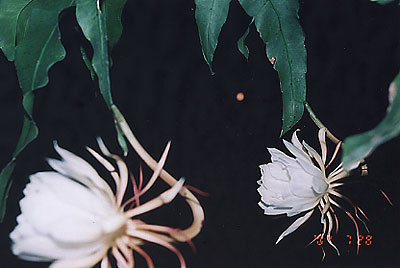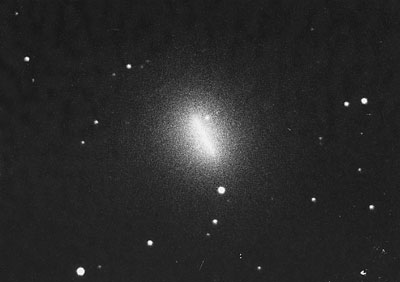July 17
Hot days continue. This must be the peak of summer heat.
There is famous tango music called "Orchids in the Moonlight", which is usually played on the harp. A "queen-of-the-night" has been bearing buds for some time, but finally began blooming late tonight. It is a rather unusual plant known to flower only once a year at night. During the day the buds were green, but around 22:00, they began to open and by 24:00 they were in full bloom. They were short-lived lasting only for a few hours and wilted before dawn. Why do they bloom late at night and whom do they expect to see them? There were no butterflies, no bees around this late at night. Only a 13-day-old moon was watching this scene hanging low in the southern sky. Do they flower only on moonlit nights? And strangely they flower only once a year.
There are people who are known to be masterful in their own fields. There are people blessed with exceptional beauty. It occurred to me that there may be also people who are equally talented and blessed but not known to the world. There may be things which are exceptional but unnoticed in secluded places. While looking at white flowers of the queen-of-the-night bathed in beautiful moonlight, I thought of people who had dedicated their lives to comet search. They lived their lives gracefully without seeking honor or fame or without being noticed.

A flowering queen-of-the-night and a 13-day-old moon
In the wake of the typhoon we had a magnificent blue sky
today. The sky seen through the window appeared deeply blue just like looking
into the depth of ocean. The stars over Geisei tonight were full of life.
The bright light of the Milky Way was overwhelming the earth and heavens.
It was vividly three dimensional giving an impression that we were truly
at the center of the universe. This reminds me of the awesome Milky Way
I saw 10 years ago from the summit of Mauna Kea.
C/2006 VZ13 (LINEAR) was initially listed as a minor planet,
but now is showing the true nature of the comet. Geisei's 60cm reflector
captured the image of this comet on its rapid southward journey in the
evening northern sky. In the 8cm finderscope it was bright at 7.5 magnitude
with a 7'-diameter coma. It will be observable for a while in the evening
sky.
After midnight I began sweeping the eastern sky. I fitted
the "navigator" (digital setting circles) to the 15cm binoculars.
M33 in Triangulum appeared surprisingly bright and large. The total magnitude
seemed to clearly exceed the 6th magnitude.
The clusters of the Pleiades and Hyades came into view in
the morning. I remembered that Mr. Ikeya near Hamamatsu discovered a 7th
magnitude comet in the Hyades around this time of 1964. It was fairly low
in the sky.
Since arriving at the observatory at 20:00, I had been kept
quite busy. A little before 4 o'clock in the morning, I headed west back
home with the morning twilight behind me. I always feel refreshed when
I have seen beautiful stars through the comet seeker during comet search.
This will be the world known only to comet hunters.

C/2006 VZ13 (LINEAR)
10-minute exposure from 21:01, July 15, 2007, J.S.T.
60cm reflector TMY 400 film


